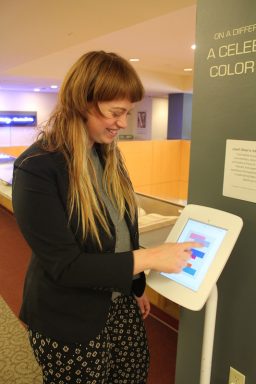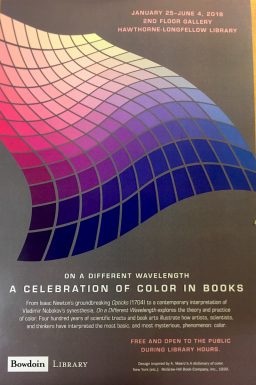An Historical Rainbow Special Collections Offers A Journey into Color
By Rebecca Goldfine












“Through Newton’s experiments, he was able to prove that light, rather than being devoid of color, is actually composed of the different spectral hues of the rainbow,” librarian Marieke Van Der Steenhoven said.
The holdings of Bowdoin’s Special Collections and Archives are often described as both broad and deep. The collections contain many thousands of books, pamphlets, maps, and other objects that touch on practically every imaginable subject. This collection is, however, not often described as “colorful.” But a new exhibition in the Hawthorne-Longfellow Library should help to highlight the vibrant visuals that are there in the collection to be uncovered.
Special Collections’ latest exhibition, On a Different Wavelength: A Celebration of Color in Books, is currently on display on the second floor of Hawthorne-Library. It explores the way color has been thought about and used through time, stretching from Aristotle, who theorized color’s origins (inaccurately, it turns out), to contemporary artist Cig Harvey’s work with neon lights.

Curated by Education and Outreach Librarian Marieke Van Der Steenhoven, the show covers a lot of ground. It includes books on 19th-century botanical medicine, the dark history of indigo (which in this country required slave labor to be profitable), and some fairly eccentric notions about the evolution of camouflage in nature. There are important historical works on color blindness, geology and mineralogy, and the advent of color printing technology. Carefully crafted works by modern-day book artists use color to explore themes of love, race, psychology, mysticism, and “our place in the world,” Van Der Steenhoven says.
A historical highlight in the show is a first-edition copy of Isaac Newton’s 1704 book Opticks, or, A Treatise of the Reflections, Refractions, Inflections and Colours of Light, which radically changed people’s ideas about color. “Through Newton’s experiments, he was able to prove that light, rather than being devoid of color, is actually composed of the different spectral hues of the rainbow,” Van Der Steenhoven said.
The show also includes a first edition of the English translation of Goethe’s 1840 Theory of Colours. “While Newton perceived color as solely a physical property of light, Goethe demonstrated the undeniable facts of subjective experience. Color, Goethe asserted, is perceived differently by each viewer. This work opened up the study of color past the science of physics to include the sciences of physiology and psychology as well,” writes Van Der Steenhoven.
Van Der Steenhoven said she hopes some viewers of the exhibition might be tempted to return to Special Collections for further investigations. “These books are beautiful to look at behind the cases, but what Special Collections has to offer is you can actually use these books and engage with them,” she said.